A trek through Bhutan part II: lessons learned and experiences shared (with VIDEO)
posted Tuesday, March 25, 2014 at 10:24 AM EDT
[If you've yet to read part I in this series from Josh Cogan, check out that piece first!]
Our journey begins
The trail for the first few days was relatively easy, and I say relatively because as a flatlander who had done little to get in shape before the trip, even a modest pitch felt like something at 10,000 feet with 35 hours of jetlag and a 12-hour time difference.
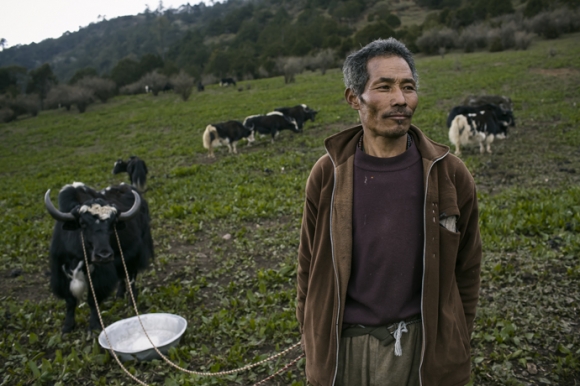
5D Mark III, 35mm f/1.4 L, f/5.0, 1/250s, ISO 320
At the lower altitudes the trails were covered with wild strawberries and evergreens. Herds of mountain yaks strolled lazily through the open woodlands. Above us we could see the rising peaks we would soon cross.
Even though I knew more majestic scenery was yet to come, I started shooting heavily early on. This landscape was different than much of what I normally get to see, and I wanted to capture the beginning of what was shaping up to be a memorable journey. I found it nearly impossible to restrain my finger from pressing the shutter button with abandon. It was okay though: I had planned for this... or so I thought.
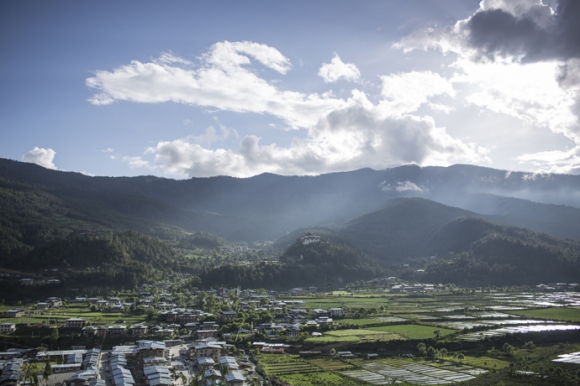
5D Mark III, 35mm f/1.4 L, f/2.5, 1/2000s, ISO 100
By the end of the second full day of hiking, my assistant and I had burned through 3 of the 5 batteries we brought. It started to enter my mind at this point that it would be better to stay out in front of the charging rather than wait until we drained all our batteries.
That night we charged from the Vagabond Mini and the Nomad, both of which I had pre-charged before coming out. That's one of the great features of the Goal Zero system, compared to other solar options: if you happen to find a traditional power source, it can also be used as a portable power pack.
By the morning, we had charged two of the dead batteries using the Nomad, and charged the 3rd dead battery and my assistant's MacBook Pro on the Vagabond Mini. While charging the two Canon batteries completely drained the Goal Zero, the Vagabond Mini was left with half its power.
Given we had 5 days left, I realized that perhaps these units wouldn’t give us exactly the freedom I was hoping for. I would need to do my best to stretch out and repower as I went.
Extreme environments demand clever improvisation
There was a challenge though. It was pouring. Constantly. How does one charge a solar pack when you are walking in a cloud all day? The answer of course is… slowly.
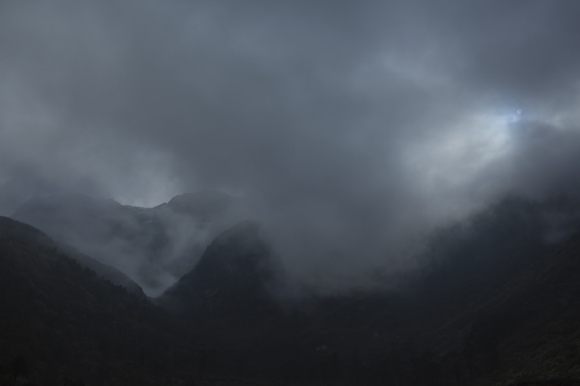
5D Mark III, 35mm f/1.4 L, f/5.6, 1/2500s, ISO 100
To add to the drama, it was nearly impossible to keep the gear accessible for quick shooting and still to keep it dry. I settled on strapping the camera to a carabiner on my shoulder strap, under a poncho.
To keep the Goal Zero charging we had to get a bit more creative. As we were hiking all day, it was tough to keep the solar panel facing towards the sky. Most days we wouldn’t get to camp until a few hours before sunset, and with the combination of cloudy days and short hours, something needed to be improvised.
After consulting with Sonam, our horse master, we strapped the solar panel to the top of the donkey, covered the inverter in a Ziploc and placed it in one of the mule baskets. While less than ideal, especially given the densely-forested passes the pack animals would take to beat us to the campsites, our mule-borne solar station at least kept the Goal Zero charging constantly.
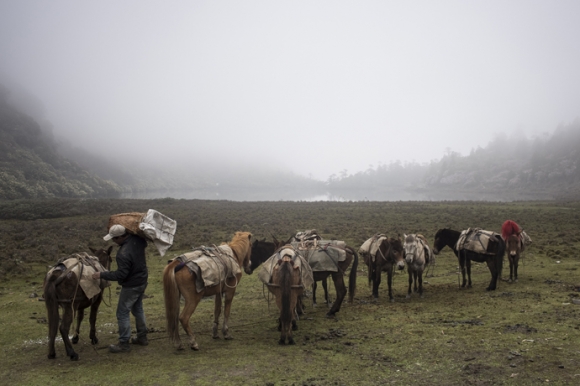
5D Mark III, 35mm f/1.4 L, f/5.6, 1/250s, ISO 640
There seemed to be a strong correlation between the mystery of the landscapes and the ethereal, ever-present rain and clouds that shrouded them. I'd had used almost all my batteries and the Goal Zero was charging between 40 and 60 percent during the very cloudy days. Fortunately, the panel was fully waterproof and didn’t seem offended by the long rainy days on the mule's back. By this point I had completely drained the Vagabond Mini, achieving about 3 full battery charges and 1 full MacBook Pro charge, so I was entirely dependent on the solar system if I was to make it through.
Generally, the mule-powered solar station would generate enough power in a day to fully charge one battery. This was a fine pace for my own shooting, but wasn’t quite enough to keep up with both cameras, as each consumed about one full charge a day with heavy shooting.
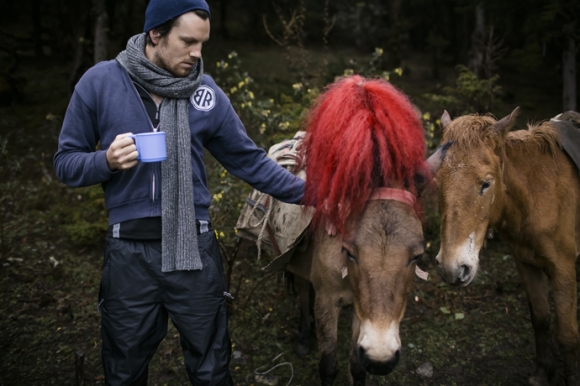
5D Mark III, 35mm f/1.4 L, f/2.0, 1/1000s, ISO 640
Saved by a turn of good weather
We were about to seriously ration our shooting when we finally had some luck with the weather. On the morning of our 5th day the weather finally cleared. Not only could we top up our batteries, but we were able to dry out our sopping wet socks!
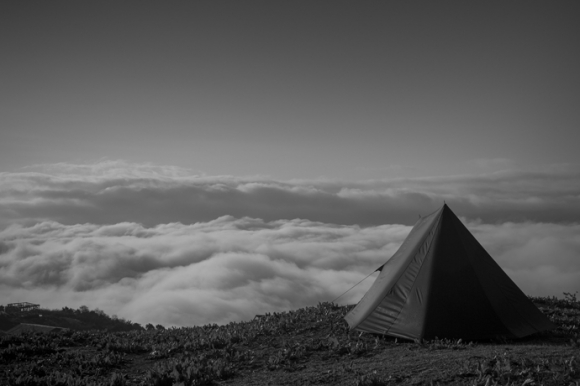
The socks were the least of our worries, though. Moisture had invaded every crevice and cranny, finding its way between every filter and lens element, nearly rendering shooting impossible. The sunny weather couldn’t have been better timed. After sticking a few pieces of gear in the Bhutanese rice bags our guides brought along, we were back in business.
With good sun at altitude, charging became a pretty easy affair. We could get the Goal Zero inverter battery fully charged in somewhere around 4-6 hours, and that was more than enough to power our shooting for the final two days of the trek.
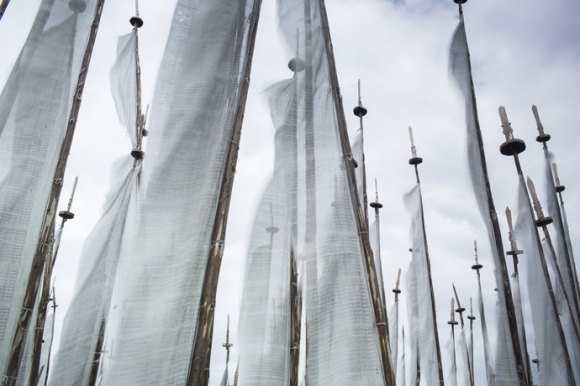
5D Mark III, 35mm f/1.4 L, f/22, 1/15s, ISO 100
The takeaway
In summary, I think that having both systems in play during the trip saved us. We were spared serious issues of pack weight by having the mules, but it was still important to keep the weight to a reasonable limit. To me there were advantages and disadvantages of both systems.
Goal Zero
The Goal Zero is a super lightweight system, and personally I like the idea of using renewable power whenever I can. While it would be foolish to claim anything about this project was carbon neutral, between our flights and transporting all our gear, at least the power for our cameras and laptop had a slightly smaller footprint. All in all, the Goal Zero system is a very reliable system if you're spending time way off-grid.

If were were shooting video heavily with the DSLR (which tends to suck more power) or making heavy use of a second camera, I would suggest investing in a single, more powerful solar system or a second Nomad 20. While the system seems to be able to handle the inclement weather and still gets a trickle of juice, charging speed plummets when you lose direct sunlight.
Vagabond Mini
The Vagabond system has a much bigger battery and consequently is able to give us a lot more juice in the field. The downside of course is that once the Vagabond is out of juice, it’s pretty serious dead weight to carry around. I also would suggest they put a cover on the switch, because more than once the simple push button power switch would turn on while in my pack (I fortunately discovered this prior to leaving!). I did find the that the Vagabond ended up having great use during the rest of the trip however, because often times when we would travel from the more major hubs in Bhutan, power in the smaller villages had was non-existent or extremely unreliable. It was useful to charge up the unit prior to departure as we could use on the road trips and days where we had no access to power supplies.
As an aside, the Vagabond unit is actually designed to power special off-camera strobes, a feat not many affordable power sources can lay claim to. Unfortunately, we weren't able to secure strobes from Paul C. Buff in time for the trip, so we can't speak to the application, only our use of the system as a well-designed power backup. If you're looking for strobe solutions to use away from civilization, the Vagabond system looks to be a good bet.

Final conclusion
In short, I would recommend bringing a few options with you. A healthy collection of pre-charged batteries is a great start and would probably work for all but the longest trips, but backing that up with 1 or 2 Goal Zero Systems, or a combination of the Vagabond Mini or similar battery solution and Goal Zero will help keep you covered. Of course, just bringing a couple dozen pre-charged camera batteries is also a viable option, but where's the fun in that?
I also feel that the investment in the SD and CF cards was a great move, they are small, solid state and thereby less likely to fail; much easier than carrying a backup hard drive around. It doesn’t hurt to have a way to dump the video and photos, but if you are primarily shooting still, it is unlikely you will be shooting much than 64 GB in a field context. The external drive is a nice backup, but if you just use the dual card slots on the Mark III to write to two separate cards, that's ample redundancy for the few days in the field. [editor's note: you'll want to keep SD cards out of your Mark III workflow if you care about buffer clearing speed. http://jeffcable.blogspot.com/2012/06/why-you-should-not-put-sd-card-in-your.html] In the best of all worlds, you would have several physical backups and a cloud system to keep them on, but the Wi-Fi in Bhutan was never fast or reliable enough to backup to a remote server.
Finally, bring all the waterproofing and drying options you can: silica packs, tarps, construction grade trash bags, dry bags and man-sized bags of Bhutanese rice were all used over the course of the trip. With all the moisture around you, wet gear is inevitable, so several solutions to get the moisture out of gear is key.







---
Joshua Cogan is a documentary, portrait and travel photographer based in Washington, D.C. His award-winning work has appeared in GQ, The New York Times, The Washington Post, The Los Angeles Times, The Travel Channel and The New Yorker. You can find him on facebook, twitter and instagram.
